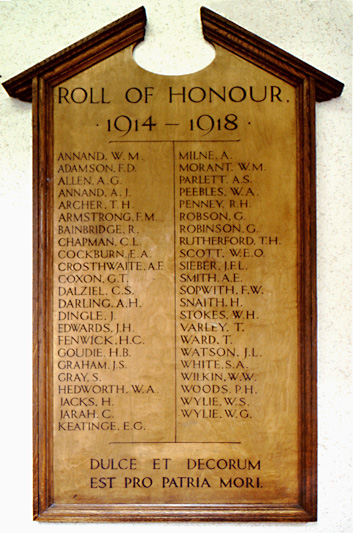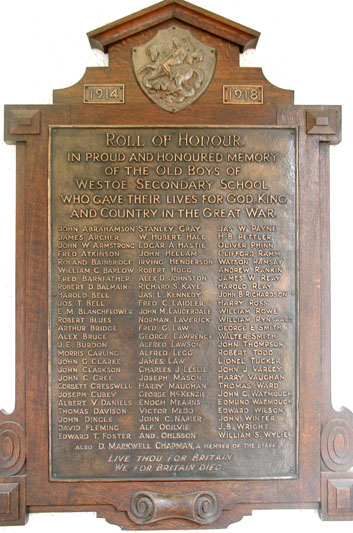| home | | | past | | | present | | | traditions | | | people | | | photos | | | site | || | the ATOM | | | school photos |
| home > the past > worldwar1 | South Shields Grammar-Technical School for Boys | |||||||||||||||||||||
| ||||||||||||||||||||||
| The First World War |
| INDEX of boys & staff who served >> Informal notes in Admission Register >> |
|||
 |
 |
||
|
The outbreak of war Austria-Hungary had taken over Bosnia, raising tensions with both Russia and Serbia. Then, through a number of wars in the Balkans, Serbia had emerged as victor. But tensions with Austria-Hungary continued, and a group of Serbian terrorists assassinated the heir to the Austrian-Hungarian throne - Archduke Ferdinand. Even though the terrorists were not connected with the Serbian government, Austria-Hungary declared war on Serbia on 28th July 1914, formally marking the start of the World War. Russia came to the aid of its Serbian allies, and Germany to its Austrian-Hungarian allies. The German response was to attack France. On their way they trampled through Belgium an act that violated its neutral status (under the 1839 Treaty of London) and which was condemned by Britain. Prime Minister, Herbert Asquith, gave Germany an ultimatum to get out of Belgium by the end of 3rd August, 1914. Germany had argued that they were going through Belgium because France was plannng to attack Germany via that route - an argument that Asquith dismissed and, as a result, Britain declared war on Germany on 4th August, 1914. Recruitment With the start of the war, the government mobilised many of the reservists, and also opened up a massive recruitment campaign. Any fit man between the ages of 18 and 38, and over 5ft 3in tall could join up (although many were rejected on the health or other grounds). Those who were accepted could choose their regiment, and may sign up for a period of 6 or 7 years (or "for the duration") to be followed by a period in the reserve. There was even a door-to-door campaign to get men to voluntarily "attest" to serve, with assurances that married men would be less likely to be called up. But this campaigning wasn't enough, and in January, 1916, the government introduced conscription. Initially only for single men aged 18-41, but widended to married men a few months later. With the number of exemptions (due to domestic or employment situations, working in reserved occupations, consciencous objections and health), it still proved difficult to raise sufficient numbers particularly as the war was a bloody one, and casualties were high. Boys' High School & Westoe Secondary School For those who lost their lived, the two schools' Rolls of Honour above provide a fairly comprehensive list of those who lost their lives. For the rest, we're fortunate that someone decided to keep an informal record in the back of the original High School Admissions Register, which gives us a good idea of those boys and staff who served and survived the war. But there is nothing like this for Westoe, and we rely on specific references to Westoe in archive materials, particularly newspapers, of which there are few. This means that the total of about 280 boys that are known to have served is very low, and it's likely that a further 200 boys from Westoe also served. We simply do not know who these were. However, we do know from the Rolls of Honour that about 45 from the High School and about 80 from Westoe lost their lives. Mistakes
On the Westoe Roll of Honour:
Some boys appear on both Rolls. These aren't mistakes as the boys were either pupils at both schools, or were taught at one and went on to teach at the other. The following page lists the names of all those Old Boys that I have discovered so far. |
|||
| ||||||||||||||||||||||
| This site and its design and contents are copyright © Mike Todd, 2001-2014 - school copyright is acknowledged - contact me | ||||||||||||||||||||||